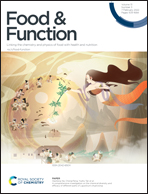A comprehensive investigation on the chemical diversity and efficacy of different parts of Ligusticum chuanxiong†
Abstract
Ligusticum chuanxiong Hort. (CX) is a medicinal and edible plant with a wide range of constituents of biological interest. Since the biomass of the non-medicinal parts of CX is huge, discarding them will cause a waste of resources. To expand the medicinal uses of CX, we comprehensively investigated the chemical diversity and efficacy of its different parts (rhizomes, fibrous roots, stems and leaves). 75 compounds in the volatile oil and 243 compounds in the methanol extracts (including 95 phthalides) obtained from CX were characterized by GC-MS and UHPLC/Q-Orbitrap MS analysis, respectively. Of 95 phthalides, 14 potential new compounds and 5 phthalide trimers were identified from CX for the first time. Phthalide monomers were more abundant in rhizomes and fibrous roots, and phthalide dimers or even phthalide trimers mainly in stems and leaves. By multivariate and univariate analyses, 22 and 24 different compounds were found in the volatile oils and the methanol extracts, respectively. In the bioactivity evaluation of different parts, stems and leaves showed the best antioxidant activity, fibrous roots showed the strongest vasodilator activity, and rhizomes showed the most significant anticoagulant activity, which was related to the different metabolites in different parts. Ultimately, this work revealed the similarities and differences of phytochemicals and bioactivities in different anatomical parts of CX. It might provide helpful evidence for the rational application of non-medicinal resources.



 Please wait while we load your content...
Please wait while we load your content...